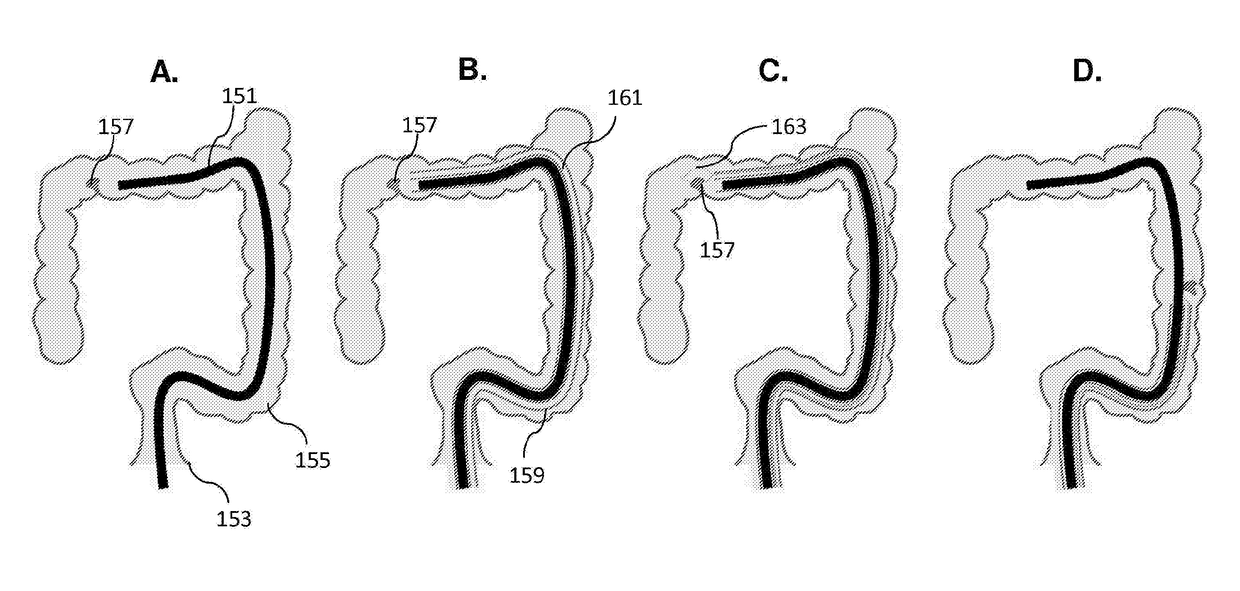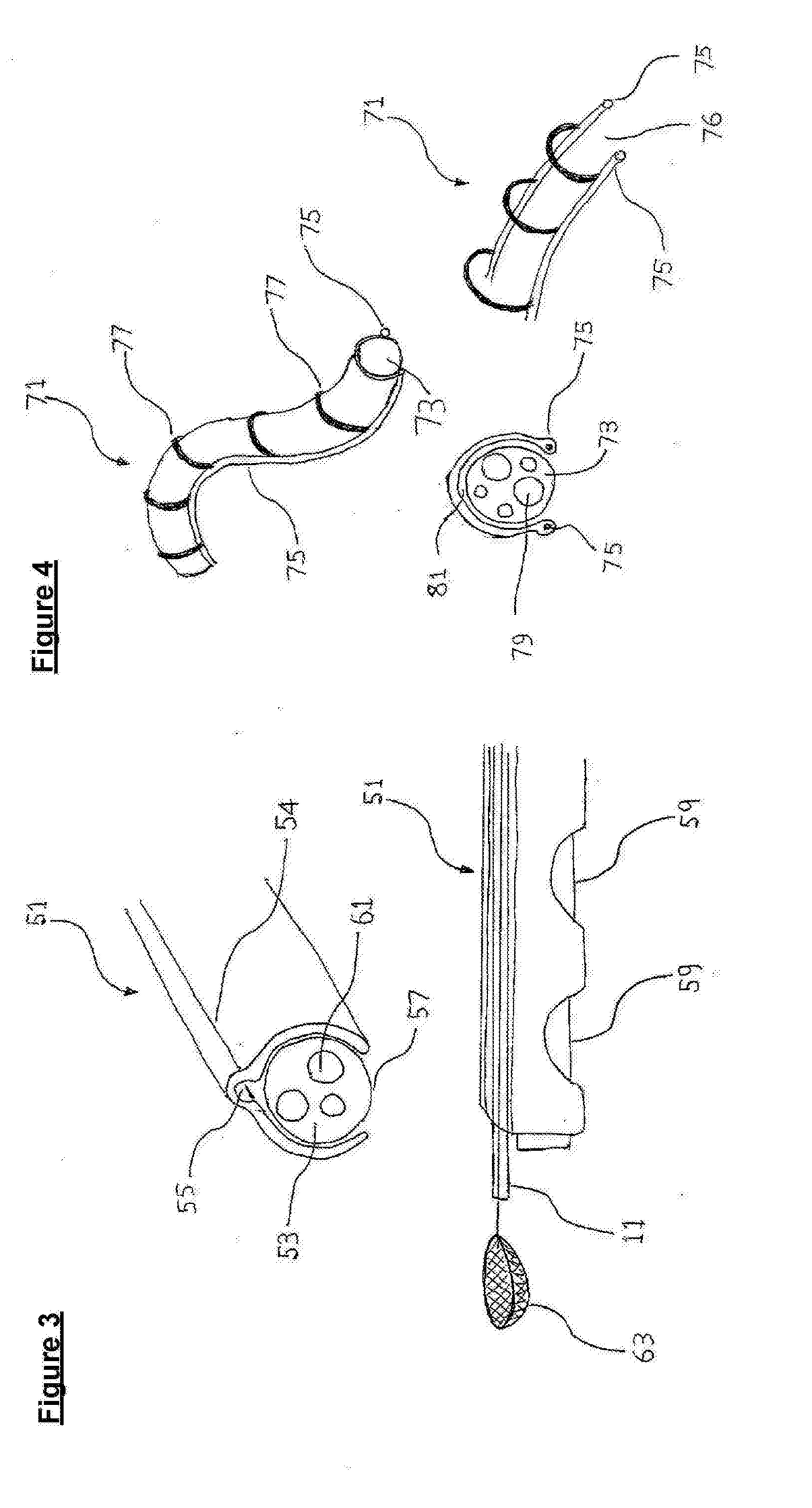Colonic polyp removal
a technology of colloidal polyps and polyps, applied in the field of instrument guides, can solve the problems of limited size of the colloidal polyp, time-consuming process, and requiring experience and dexterity on the part, and achieve the effect of sufficient friction
Inactive Publication Date: 2018-11-08
SALFORD ROYAL NHS FOUND TRUST
View PDF0 Cites 0 Cited by
- Summary
- Abstract
- Description
- Claims
- Application Information
AI Technical Summary
Benefits of technology
The invention allows for a surgical instrument to be passed repeatedly through the channel of a guide during a procedure, which can reduce the risk of damage to the colon and discomfort to the patient. Also, withdrawal of the excised polyp may be done by withdrawing down the channel of the guide, which may further minimize or reduce the need for withdrawal and re-insertion of the colonoscope into the colon.
Problems solved by technology
However, the size of these channels is limited due to the size constraints placed on the colonoscope.
This process is time consuming and requires experience and dexterity on the part of the surgeon or clinician.
However, removal of larger polyps (for example polyps with a size greater than 1 cm), which are often more advanced, pose more of a problem.
However, once the polyp is contained within the Roth net, the polyp cannot be removed through the colonoscope channel because the polyp is too large to pass through the channel.
This is difficult if multiple polyps are captured in a single Roth net.
Therefore, when multiple polyps are present (in 10-30% of cases) the colonoscope must be inserted and removed from the bowel multiple times. Not only does this result in discomfort for the patient but, in addition, only a certain number of re-insertions will be tolerated and there is therefore an increased likelihood that a malignant polyp will go undetected.
Multiple re-insertions also increase the time taken to screen each patient, placing further strain on the resources of the healthcare system.
However, occasionally insertion of the colonoscope may cause damage to the colon lining which can, in certain instances, result in bleeding, infection and / or perforation of the bowel.
The likelihood of such complications is increased when multiple re-insertions of the colonoscope are required.
Method used
the structure of the environmentally friendly knitted fabric provided by the present invention; figure 2 Flow chart of the yarn wrapping machine for environmentally friendly knitted fabrics and storage devices; image 3 Is the parameter map of the yarn covering machine
View moreImage
Smart Image Click on the blue labels to locate them in the text.
Smart ImageViewing Examples
Examples
Experimental program
Comparison scheme
Effect test
first embodiment
[0053]FIG. 1: Schematic representations of a guide according to the present invention mounted to a colonoscope;
second embodiment
[0054]FIG. 2: Schematic representations of a guide according to the present invention mounted to a colonoscope;
third embodiment
[0055]FIG. 3: Schematic representations of a guide according to the present invention mounted to a colonoscope;
the structure of the environmentally friendly knitted fabric provided by the present invention; figure 2 Flow chart of the yarn wrapping machine for environmentally friendly knitted fabrics and storage devices; image 3 Is the parameter map of the yarn covering machine
Login to View More PUM
 Login to View More
Login to View More Abstract
Herein described is an instrument guide for use with a colonoscope, the guide being adapted to be mounted to the colonoscope. The guide defines a channel along which an instrument can be passed during use. Also described is a method of removing a polyp from a colon including inserting a colonoscope into the colon, inserting an instrument guide into the colon, mounting the guide to the colonoscope, inserting an excision instrument, excising a polyp and withdrawing the excised polyp from the colon.
Description
FIELD OF THE INVENTION[0001]The present invention relates to an instrument guide for use with a colonoscope. The invention further relates to a method of removing a polyp from the colon and a kit of parts comprising a colonoscope and guide, or guide and applicator for the guide.BACKGROUND OF THE INVENTION[0002]Colorectal cancer is the third most common cancer in the UK with approximately 35,000 new cases diagnosed each year. The majority of these colorectal cancers are caused by colonic polyps, small growths on the inner lining of the colon, which are extremely common, especially in the over 60s. Polyps are often harmless but can progress from benign to malignant growths, if left untreated.[0003]Regular bowel cancer screening has been shown to reduce the risk of dying from the disease by 16%. Screening in the UK is offered to men and women aged 60 to 69 and involves testing for blood in the faeces. If an abnormal result is obtained, the patient is offered a colonoscopy which involve...
Claims
the structure of the environmentally friendly knitted fabric provided by the present invention; figure 2 Flow chart of the yarn wrapping machine for environmentally friendly knitted fabrics and storage devices; image 3 Is the parameter map of the yarn covering machine
Login to View More Application Information
Patent Timeline
 Login to View More
Login to View More IPC IPC(8): A61B1/31A61B1/00A61B1/018A61B17/221
CPCA61B1/31A61B1/00078A61B1/00135A61B1/018A61B1/00154A61B1/0014A61B17/221
Inventor THOMAS, JOANNE MARIEHEATON, KEITH PATRICKHARDMAN, IAN JAMESCORDEN, JAMES MATTHEWCARLSON, GORDON
Owner SALFORD ROYAL NHS FOUND TRUST
Features
- R&D
- Intellectual Property
- Life Sciences
- Materials
- Tech Scout
Why Patsnap Eureka
- Unparalleled Data Quality
- Higher Quality Content
- 60% Fewer Hallucinations
Social media
Patsnap Eureka Blog
Learn More Browse by: Latest US Patents, China's latest patents, Technical Efficacy Thesaurus, Application Domain, Technology Topic, Popular Technical Reports.
© 2025 PatSnap. All rights reserved.Legal|Privacy policy|Modern Slavery Act Transparency Statement|Sitemap|About US| Contact US: help@patsnap.com



